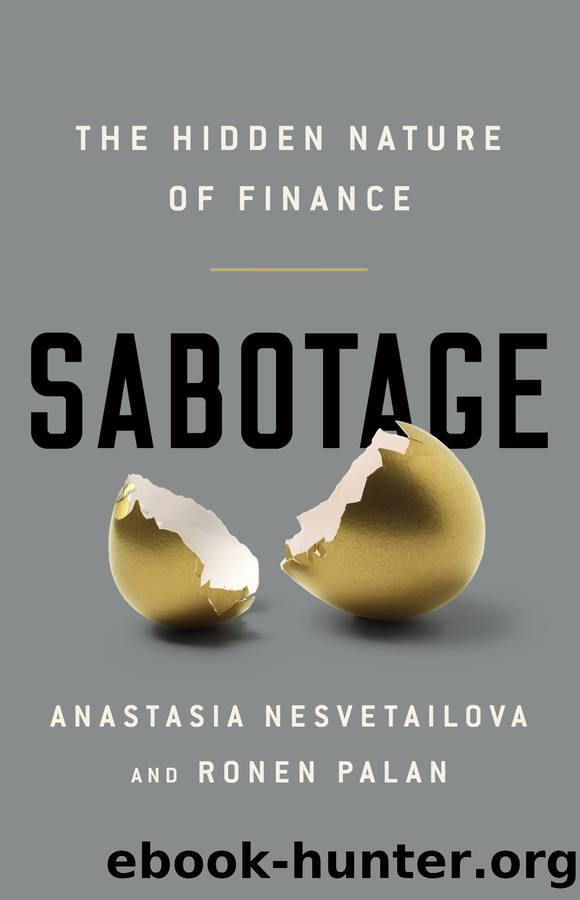Sabotage by Anastasia Nesvetailova

Author:Anastasia Nesvetailova [Nesvetailova, Anastasia and Palan, Ronen]
Language: eng
Format: epub
Publisher: PublicAffairs
Published: 2020-01-28T00:00:00+00:00
BARCLAYS GETS THE UPPER HAND
It is less clear what motivated Barclays to pursue the bidding for ABN AMRO for so long. Barclays knew that RBS was about to buy an overvalued ABN, but as long as Barclays stayed in the race, the costs for its rival would remain high. This, in turn, came to the benefit of ABN’s hedge fund shareholders and surely also to Barclays. Retrospective evaluation of the RBS books shows that without the acquisition of ABN the Scottish bank would have more or less broken even between 2008 and the first half of 2009. ABN accounted for 75–144 per cent (depending on different estimates) of the combined group’s operating losses in the same period.29
So did Barclays put RBS on the path to collapse? It may be that Barclays played a very clever game. Or perhaps it was sheer good luck. Barclays certainly appears to have tried to compete with RBS. Barclays Capital, for instance, sought to rally several hedge funds to weaken the consortium partner Fortis by short-selling its shares ‘and kill its planned €13.5bn rights issue’.30 This could have destroyed the position of the consortium, but the strategy failed because most hedge funds were betting in favour of ABN shares and preferred that the RBS consortium keep their price high.
In any case, by August 2007 Barclays’ own share price fell, reducing the value of its share-based offer even more. The British lender required the Bank of England stand-by facility to borrow an unusually high amount of £1.6bn at a penal rate of 6.75 per cent.31 Although Barclays blamed the liquidity injection on a technical breakdown in the clearing system, it was the second time in two weeks that Barclays had to rely on the mechanism. Days prior to the drop in share price, several leading figures left Barclays Capital. They were in charge of collateralized debt obligations (CDOs) and the construction of structured investment vehicles (SIVs).32 A departure of high-ranking staff sent jitters through the global financial markets and was an early indicator of Barclays’s exposure towards toxic American debt. This was confirmed a few months later when Barclays had to raise capital to avoid a government bailout. Starting in June 2008, it received a total of £6.1bn in two payments, from Qatari and Singaporean investors.33
As the Barclays share price dropped, it could no longer compete with the RBS-led consortium. Yet although Barclays knew what was on the books of ABN – more toxic debt – it kept its position in the race for ABN up to October 2007. Observers at the time were puzzled. The Telegraph wrote: ‘It seems extraordinary that Barclays and RBS are so desperate to buy this second division bank at such a massive premium when the world’s best banks, such as Goldman Sachs and Morgan Stanley, are off 14pc and 27pc respectively in the past month.’34 Most experts agreed that ABN’s share price had been overvalued because of the bidding competition. It was estimated: ‘Without the bid interest ABN shares would probably plummet 40pc.
Download
This site does not store any files on its server. We only index and link to content provided by other sites. Please contact the content providers to delete copyright contents if any and email us, we'll remove relevant links or contents immediately.
International Integration of the Brazilian Economy by Elias C. Grivoyannis(57319)
The Radium Girls by Kate Moore(10907)
Turbulence by E. J. Noyes(7037)
Nudge - Improving Decisions about Health, Wealth, and Happiness by Thaler Sunstein(6633)
The Black Swan by Nassim Nicholas Taleb(6190)
Pioneering Portfolio Management by David F. Swensen(5605)
Rich Dad Poor Dad by Robert T. Kiyosaki(5147)
Zero to One by Peter Thiel(4824)
Man-made Catastrophes and Risk Information Concealment by Dmitry Chernov & Didier Sornette(4735)
Secrecy World by Jake Bernstein(3782)
Millionaire: The Philanderer, Gambler, and Duelist Who Invented Modern Finance by Janet Gleeson(3568)
Skin in the Game by Nassim Nicholas Taleb(3459)
The Age of Surveillance Capitalism by Shoshana Zuboff(3422)
The Money Culture by Michael Lewis(3284)
Skin in the Game: Hidden Asymmetries in Daily Life by Nassim Nicholas Taleb(3264)
Bullshit Jobs by David Graeber(3179)
The Dhandho Investor by Mohnish Pabrai(3167)
The Wisdom of Finance by Mihir Desai(3077)
Blockchain Basics by Daniel Drescher(2890)
